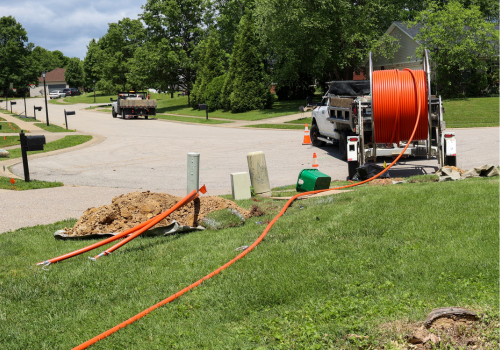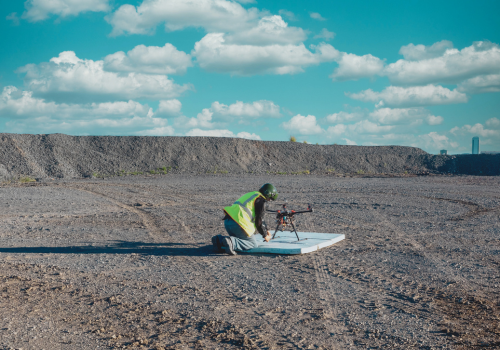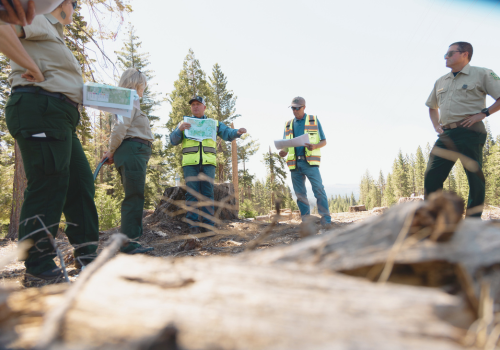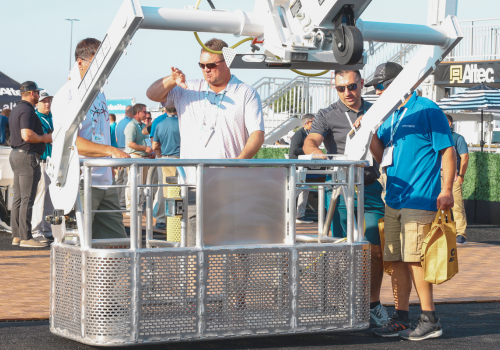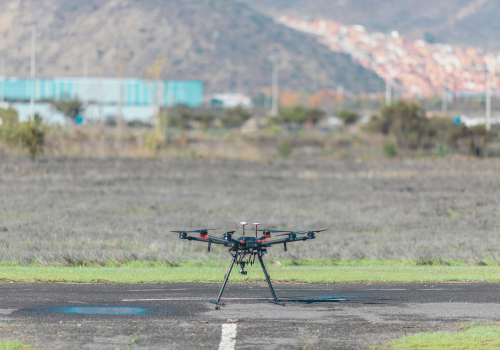Ride-on trencher manufacturers have focused on making equipment that is more versatile and easier to use. The timing is perfect, given that demand for underground infrastructure and broadband continues running hot, and the availability of skilled equipment operators continues running thin.
One manufacturer, Ditch Witch, has placed considerable emphasis on making its ride-on trenchers more versatile, allowing contractors to tackle more projects with the same machine. For example, the RT80 and new RT70 tractors feature a more modular design. This allows for the use of either tires or tracks.
“Utility contractors have always been able to change rear attachments to take on different jobs,” says Steve Seabolt, Heavy-Duty Tractor Product Manager at Ditch Witch. “But to operate with either tires or tracks, there has always been a need for two machines. Now it’s just a matter of bolting them on and changing a setting in the software.”
Technology from Vermeer is designed to simplify the process of switching attachments. Vermeer’s i2 denotes “interchangeability and intelligence”. It’s currently available on the RTX1250i2 and XTS1250i2 ride-on utility tractors.
“The interchangeability piece relates to the attachments,” says Ed Savage, Lead Product Manager at Vermeer. “If you’re using a trenching attachment, for instance, i2 makes it easier to switch to a plow or rock wheel just by the way we’ve designed the mounting.”
With the intelligence piece, i2 electronically knows which attachment is on the tractor, allowing it to instinctively change parameters such as pressure settings to ensure optimum operation. “The operator doesn’t have to worry about any of that anymore, which makes the machine much easier to operate,” Savage points out.
Smarter, more automated trenching
With the skill level of some of today’s newer operators, it can take quite a bit of training before they become productive. Manufacturers like Vermeer and Ditch Witch have taken aim at this common contractor pain point.
TrenchSense is one example from Vermeer. When running a trenching attachment, operators will often hit things like rocks and tree roots which typically stall out the digger chain. TrenchSense simplifies the process of escaping an obstruction.
“Traditionally, the operator would have to stop the machine and put the digger chain back to neutral, back the machine up, raise the boom, re-engage the digger chain, and attempt moving forward again to work through the obstruction,” Savage explains. “TrenchSense automates that entire process.”
Ditch Witch has developed a technology with similar functionality.
“Ditch Witch anti-stall technology allows the operator to simply push a button to initiate a sequence of stopping the ground drive, backing the tractor up slightly, and reversing the digging chain rotation to clear the obstruction,” Seabolt explains. “Then the machine resumes forward rotation of both the chain and ground drive.”
Another Vermeer innovation is Auto Plunge. Savage says this technology aims to address the difficulty many new operators have when executing their initial cut with a trenching attachment or rock saw.
“It’s pretty easy to stall out the cutting chain if you don’t do it right,” Savage points out. “Auto Plunge senses engine rpm. If it notices that the engine is starting to pull down, it eases up on how fast it is plunging into the ground.”
Ditch Witch has developed a Trench Depth Meter. This technology tells the operator how far and deep they are trenching in real-time, eliminating the inefficient process of using tape measures and measuring wheels.
“Trench Depth also has some logging capability where the operator can see history,” Seabolt points out. “Data can be pulled off of the machine and onto a USB drive. Combined with separate GPS mapping data, this can feed into the customer’s as-built system or GIS system.”
The Ditch Witch Trench Depth Meter is currently an optional feature on the RT70 tractor. However, the company plans to offer this in additional tractor models soon.
 Smarter powertrain management
Smarter powertrain management
As Vermeer’s Savage explains, every engine has a certain range of rpm’s where it develops the most torque and is the most productive. Vermeer’s Productivity Zone technology finds that sweet spot without burdening the operator.
“In the past, we had something called ‘auto creep’ where different settings, switches, and dials allowed the operator to manually set everything to get the most productivity,” Savage explains. “But operators were constantly having to adjust things. With Productivity Zone, this is done automatically. It keeps the engine in that most productive window so the operator doesn’t even have to think about it anymore.”
EcoIdle is another intelligent technology from Vermeer. If the tractor senses that a machine function hasn’t been activated for 15 seconds, such as engagement of the ground drive or an attachment, it will automatically take the engine down to a slow idle. This helps the operator reduce unnecessary noise and fuel burn without having to do a thing.
Ditch Witch has developed a technology that helps match power and speed to ground conditions. The RT70 tractor features a two-speed gearbox and three-speed on-the-fly shifting. To shift the mechanical gearbox, tractor motion must be stopped like normal. But then, to shift the hydraulic motor while the machine is still moving, the operator simply turns a knob that’s positioned to the left of the steering column.
“If you get into some tougher ground conditions and need to shift down to get a bit more power instead of speed, it’s easy to do without having to stop the machine and shift it,” Seabolt explains. “You can also shift up to take advantage of easier ground conditions.”
Those three on-the-fly speeds, in combination with the two-speed gearbox, give operators six possible speeds. In addition to the RT70, other larger Ditch Witch machines offer this same feature.
One innovation that is currently exclusive to the Ditch Witch RT70 is “crab and coordinated steering.” That won’t be for long, though, as Ditch Witch plans to incorporate it on other models over the next couple of years. This feature allows operators to turn the tractor with just the steering wheel, as opposed to needing a second lever to steer the rear axle separately.
“The traditional method of steering requires manual coordination and a bit of a learning curve,” Seabolt says. “Now operators just turn the steering wheel to make both axles do what they want depending on which mode the machine is in.
“In coordinated steering mode, the rear axle turns opposite of the front, allowing the operator to turn a tighter radius,” Seabolt continues. “The operator can also drive the machine in a ‘crab style’ where the front and rear axles are pointing in the same direction and the machine moves somewhat diagonally. Crab mode is beneficial when you’re plowing and want the machine to be closer to a fence line or building, or maybe hanging off the edge of a roadway when you’re driving on the roadway.”
Operator comfort
Trencher manufacturers have also been making design improvements to enhance operator comfort.
Ditch Witch’s RT70 tractor features a seat that swivels 120° (90° right, 30° left). “This allows the operator to position him or herself to ensure maximum visibility of the machine and work area,” Seabolt explains. At the same time, an informational display on the armrest shows all of the important operating parameters. Seabolt says an operator can glance at the display while looking back at the plow, helping him or her do the job better and more efficiently.
The 120° swivel seat is part of a broader effort by Ditch Witch to improve the overall operator station. Seabolt says it’s now a very open station with an enhanced line of sight to the rear and front of the machine, as well as the sides and tires when working close to curbs, buildings, or other obstacles.
A new centrifugal fan design has also improved operator comfort.
“With a traditional axial fan, you’re either pulling air in or pushing it across the cooler where it gets hotter and then across the engine where it gets even hotter,” Seabolt explains. “That hot air ultimately winds up near the operator. Our new centrifugal fan design pulls cool air in front of the machine and also into the back of the fan from the engine compartment. The air is then exhausted out both sides of the unit at a high velocity. The benefit is a much cooler workspace.”
To further cool the operator station, Ditch Witch has moved the hydraulic valves and pumps below the floorplate. “All that is in the operator’s environment now are electrical controls that don’t put off significant heat,” Seabolt points out.
Vermeer has focused on improving the layout of its operator controls. Since its operator station rotates to the right, all of the controls are now on the right. Vermeer has also taken steps to make its climate-controlled operator’s cab extremely quiet.
All of these technologies and design improvements are part of making productive trenching equipment that helps solve the pain points of today’s utility contractors — pain points that largely revolve around operator training, comfort, and productivity.
Subscribe to The Utility Expo monthly newsletter to receive more industry insights like this.
Read Next
Pros - Cons Of A Vacuum Excavator
HDD Innovations Help Contractors Put More Product In The Ground And More Profit In Their Pockets


